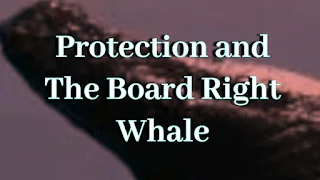Protection and The Board Right Whale
Changes in dissemination and accessibility of prey, Environmental change, Trap in fishing gear, Living space debasement, Sea clamor, Little populace size, Vessel strikes
Two different types of right whales exist: the North Pacific right whale, which is tracked down in the North Pacific Sea, and the Southern right whale, which is tracked down in the southern half of the globe. Right whales are baleen whales, benefiting from copepods (minuscule scavangers) by stressing colossal volumes of sea water through their baleen plates, which behave like a sifter.
By the mid 1890s, business whalers had pursued North Atlantic right whales extremely close to elimination. (They got their name from being the "right" whales to chase since they drifted when they were killed.) Whaling is as of now not a danger, yet they have never recuperated to pre-whaling numbers, human connections actually present the most serious risk to this species. Trap in fishing stuff and vessel strikes are the main sources of North Atlantic right whale mortality. Expanding sea commotion levels from human exercises are likewise a worry since the clamor might slow down right whale correspondence and increment their feelings of anxiety.
NOAA Fisheries and our accomplices are committed to monitoring and reconstructing the North Atlantic right whale populace. We utilize different creative strategies to study, safeguard, and recuperate these imperiled whales. We connect with our accomplices, including the fishing and delivery businesses, as we foster guidelines and the board designs that cultivate sound fisheries and diminish the gamble of ensnarements, dial back vessel traffic, and lessen sea clamor.
Peruse the North Atlantic Right Whale Situation Arranging Rundown Report
Populace Status
North Atlantic right whales have been recorded as imperiled under the Jeopardized Species Act beginning around 1970. There are roughly 360 people remaining, including less than 70 reproductively dynamic females. Human effects keep on undermining the endurance of this species. The quantity of new calves brought into the world as of late has been sub optimal.
An infographic showing yearly populace gauges for North Atlantic right whale somewhere in the range of 2007 and 2023. The infographic additionally shows the yearly calf count for those years. On the right hand side there are measurements from the North Atlantic right whale Surprising Mortality Occasion (123 creatures, including 39 dead, 33 truly harmed, and 51 sublethally harmed/sick).
They have encountered a continuous Surprising Mortality Occasion beginning around 2017, which incorporates sublethally harmed or sick, truly harmed, and dead right whales. The whales influenced by the UME address in excess of 20% of the populace, which is a huge effect on a jeopardized species where passings are dominating births. Also, research exhibits that somewhere around 1/3 of right whale passings are reported.
Appearance
North Atlantic right whales have stocky dark bodies with no dorsal balances, and their blow spouts are molded like a "V." Their tails are wide, profoundly indented, and all dark with a smooth following edge. Their guts might be all dark or have sporadically formed white patches. Pectoral flippers are moderately short, expansive, and paddle-molded. Calves are around 14 feet upon entering the world and grown-ups can develop to lengths of 52 feet.
Their heads have bumpy white patches of unpleasant skin, called callosities, which seem white in view of whale lice (cyamids) covering their generally dark skin. Each right whale has a remarkable example of callosities that researchers use to recognize individual whales, a significant device in following populace size and wellbeing. Aeronautical and transport based studies and the North Atlantic Right Whale Consortium's photograph ID data set kept up with by our accomplices at the New Britain Aquarium assist with following people throughout the long term.
Conduct and Diet
While survey right whales, you could see these tremendous animals breaking and afterward crashing down with a loud sprinkle. You could likewise see them swimming alongside their platform out of the water as they skim feed on thick fixes of microscopic fish. Right whales feed by opening their mouths while swimming gradually through huge patches of copepods and other zooplankton. They sift through these little organic entities from the water through their baleen, where the copepods become caught in a knot of hair-like material that behaves like a strainer. Right whales feed anyplace from the water's surface to the lower part of the water section.
Gatherings of right whales might be seen effectively associating at the water's surface, known as surface-dynamic gatherings, or Hangs. Mating and mingling happens in Lists, which are seen during all seasons and in all territories.
Right whales impart utilizing low-recurrence groans, moans, and heartbeats, which might keep in touch between people, convey dangers, signal hostility, or be utilized for other social reasons.
Where They Reside
North Atlantic right whales basically happen in Atlantic seaside waters on the mainland rack, despite the fact that they additionally are known to go far seaward, over profound water.
Right whales move occasionally and may travel solo or in little gatherings. In the spring, summer, and into fall, large numbers of these whales can be tracked down in waters off New Britain and further north into Canadian waters, where they feed and mate.









0 Comments